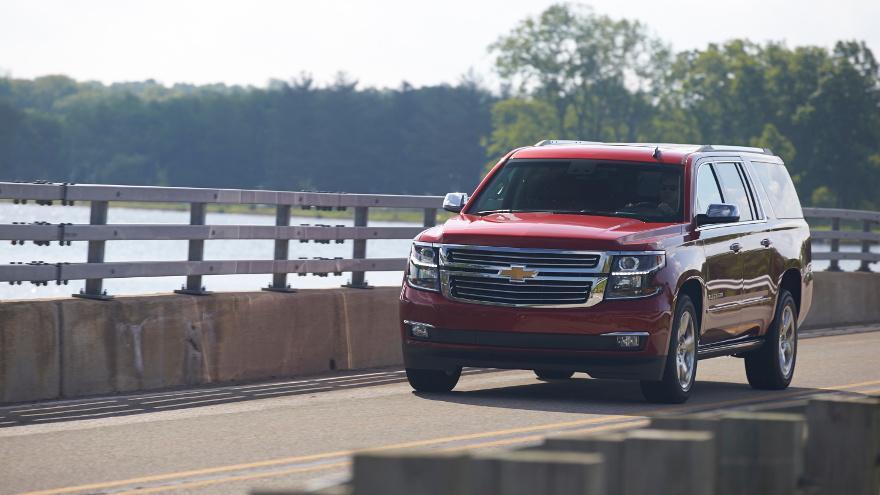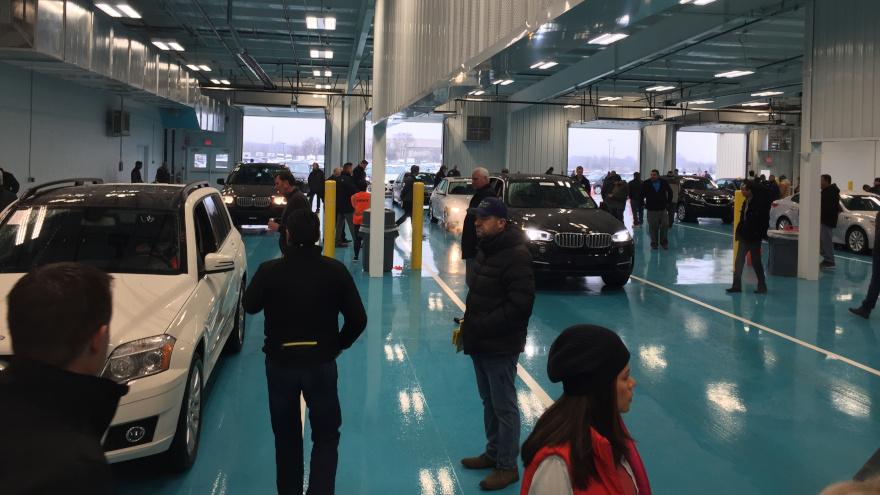A “turning point.”
That’s how AutoIMS described the third quarter for the wholesale auto industry, which hit a few “firsts” in certain consignment metrics included in the company’s Industry View report.
The report, released quarterly, is a “compendium of metrics featured in the AutoIMS Sales Scorecard that reflects the AutoIMS database (with a few needed exclusions) — a vast majority of the commercial sales volume at wholesale auto auctions in North America.”
One of the positive shifts in the AutoIMS data happened in August, when …
Read more
Wholesale vehicle volumes are expected to decline for the third straight year, with a 7% decline projected for 2022, according to wholesale flow forecasts included in Cox Automotive’s latest Manheim Used Vehicle Value Index presentation.
The biggest driver in the declining numbers of cars making their way into wholesale has been the drop-off in lease returns, as it becomes more advantageous for dealers and consumers to keep those vehicles. Meantime, the dominant force in wholesale volumes continues to be units consigned by dealers.
Specifically, there will likely be …
Read more
Not only is it challenging for dealers to find used-car supply, the number of competitors vying for that supply in the auction lanes has increased.
According to the latest Wholesale Market Update from J.D. Power Valuation Services, there have been 1.37 million wholesale auction sales of vehicles up to 8 years old through four months of the year.
That’s down from …
Read more
Through two months of the year, wholesale auction sales of used vehicles up to 8 years in age are down 15% year-over-year, with most of that softening happening in the premium segment.
That’s according to the latest Wholesale Market Update from J.D. Power Valuation Services, which said there was a combined total of approximately 594,000 of these sales in January and February.
In the first two months of 2021, auction sales volume …
Read more
Some good news-bad news for dealerships’ used-car operations.
Sales are somewhat soft, but supply is improving — in fact, days' supply of unsold retail used vehicles is at its highest level in more than a year, according to Cox Automotive.
Read more
Experian’s closing installment of its State of the Automotive Finance Market report for 2018 indicated vehicles with the highest market share for new-model leasing included SUVs like the Chevrolet Equinox, Toyota RAV4, Nissan Rogue and Jeep Grand Cherokee as well as Honda’s popular sedans, the Civic and Accord.
Those particular vehicles could be part of Black Book’s projected used-vehicle supply swell of more than 560,000 additional 3-year-old units surfacing during the second half of 2020 and into the first part of 2021.
However, there’s one potential catch for those units that often make for prime candidates to be certified pre-owned inventory. And it’s not just because of delayed lease returns resulting from lease extensions offered by OEMs during the pandemic.
“We are starting to see an incremental influx of used inventory coming to the marketplace that we expect to last into the first half of 2021, resulting from prolonged lease return delays,” Black Book said in its latest COVID-19 Market Insights released earlier this week.
“It seems that most of these vehicles never make it to auctions as grounding dealers keep the inventory for retail sales,” Black Book added.
For franchised stores that might not be seeing a host of lessees contacting them to be the grounding dealership, Black Book noted the rental lane at their favorite auction could be the place to find inventory to certify.
Black Book projected that at least 250,000 off-rental units that are 1- to 2-year-old vehicles will be added to the wholesale market during the second part of 2020, too, because of “extensive de-fleeting by rental car companies due to lack of consumer and business traveler demand and financial pressure to raise cash.”
So if dealers somehow can find those off-lease SUVs — or perhaps even highly coveted full-size pickups like the Ford F-150 and RAM 1500 that Experian also mentioned among the top 10 units for lease market share to close 2018 — it might be dealerships’ best opportunity to capitalize on fertile used-supply volume.
“With the reduction in retail and fleet sales over the next several years, we project a substantial decrease of available used inventory in the years to come,” Black Book said, projecting that overall wholesale supply could soften by 3% in 2022, 2% in 2023 and 3% in 2024.
In the first half of 2019, there were 5.2% more vehicles 5 years old or younger running through the auction lanes than there was a year ago, according to J.D. Power Valuation Services.
The company’s latest Guidelines report showed a slight uptick (0.3%) in auction volume for this group of vehicles in the final month of the half, despite a 13.7% slide from May.
“In 2019, the largest volume increases are still being observed among SUV segments,” J.D. Power said in its report. “This is a trend that will continue as more of these models are sold on the new side of the market.”
For instance, there has been a year-to-date increase of 25.6% in compact SUV volume and a 14% increase for midsize SUV volume.
Comparing new-car volume to wholesale used
In a separate report, Cox Automotive looked at wholesale market volumes and compared them to how segment share of new-vehicle sales is trending.
According to the company’s Wholesale Market Insights report, 48% of Manheim sales this year have been cars, 36% have been SUVs, 11% have been pickups and 5% have been vans.
While the respective shares for pickups and vans have largely been relatively steady in recent years, cars have been on the decline since 2015 and SUVs have been on the upswing.
Turning to the new-car sales market, the share for SUVs is at 48%, steady with year-ago figures, but consistently rising since 2012. Cars, meanwhile, have been on the decline since 2012 and are at 30% share this year.
Pickups are at 17% and vans are at 5%.
The used-vehicle market, both retail and wholesale, is skewing younger.
Two out of every three used vehicles retailed by franchised dealers in the first quarter were 4 years old or newer, according to the latest Used Vehicle Report from Edmunds.
And on the wholesale side, there has been a 5.4% year-to-date increase through May for auction volumes of vehicles 5 years old and newer, J.D. Power says in its latest Guidelines report.
Driven by increases in off-lease volume, the result is a crop of pre-owned units not all too different than their new-car counterparts in terms of technology perks and favoring SUVs, but still offering a better price bargain.
Younger, lower-mileage and lots of SUVs
Thanks to the fact that off-lease units now “dominate” used supply at franchised dealerships, the average age on these used vehicles at franchised stores is 4.3 years old, according to Edmunds.
The average mileage is at 51,349, said Edmunds, whose report focused on the franchised dealer side of the market.
Compare that to 2013, when the average age was 5 and the average mileage was 60,542.
Not to mention, more of these vehicles are SUVs, Edmunds found.
SUVs had a 40% share of the used-car market in Q1, versus their 32% share five years ago.
“Some shoppers have the misconception that used vehicles are these old, beat-up disasters waiting to happen, but that couldn’t be further from the truth in 2019. Used vehicles today actually look a lot like new vehicles,” Ivan Drury, senior manager of industry analysis at Edmunds, said in a news release.
“Limited sales during the recession mean that older cars are scarcer, and thanks to record sales and leasing during the recovery, the typical used vehicle is looking more like a late model-year SUV with low mileage and lots of great features,” Drury said.
Features like Bluetooth and backup cameras, which were more widely available on 2015 model-year vehicles (nearly 80% had Bluetooth, over 50% for backup cameras) than 2009 model-year rides (40% and less than 20%, respectively), Edmunds said.
The availability of keyless entry climbed from 20% in 2009 to around 50% in 2015. Other tech features have shown similar hikes.
“Popular vehicle technology has proliferated across the spectrum of vehicles in the past decade and an increasing number of features are now available on the used market,” Edmunds said in the report. “These features that focus on connectivity and convenience have been big selling points for consumers while cutting-edge technology revolving around electrification and automated driving hasn’t yet struck a chord with the masses.
“The wider availability of features such as Bluetooth integration and backup cameras on used vehicles reduces the differentiation between the two markets and further lessens the advantage of buying new.”
And so, too, may be the pricing gap.
Difference in price tags ‘continues to widen’
Average retail transaction prices on used cars were at $20,247 in the first quarter, an all-time high for Q1, Edmunds said, thanks to these vehicles being from larger segments, along with being newer and having greater amenities.
What’s more, there has been 17.4% runup in used prices since 2014. Meanwhile, new-car prices have climbed 14.7% in the last five years, Edmunds said.
But there is still a considerable gap between used and new, the latter having reached an average transaction price of $36,597 in Q1.
“Although used-car prices are up year-over-year, the gap between new and used continues to widen,” said Drury. “And, now that used cars are starting to mirror new ones in terms of available features, body types and mileage ― all while presenting tremendous savings to shoppers ― used vehicles are a more compelling alternative than they’ve ever been.”
Big numbers for later-model at auctions, too
Dealers attending wholesale auto auctions might notice a similar youth movement in supply there, as well.
J.D. Power data in Guidelines shows that through May, year-to-date auction volume for vehicles 5 years old and newer has reached 1.78 million units, which beats prior-year figures by 5.4%.
For the month of May, that volume was down 1.8% year-over-year and up just 1% month-over-month.
Still, J.D. Power is still expecting this year to be the height of auction volume for this age group.
“Used supply for units up to 5 years in age is expected to increase and peak in 2019, before leveling off in 2020 and 2021,” analysts said in Guidelines. “The anticipated increase will be fueled by increases in off-lease volume.
“Retail, rental and commercial volumes are also expected to increase in 2019, however, not nearly to the same degree as off-lease volume,” they added.
Much like Edmunds observed on the retail side, there has been a been lift in volume for younger larger segments.
Among the crop of 5 years old and newer vehicles, midsize pickup auction volume is up 32.5% year-to-date, compact premium SUV volume is up 29.5% year-to-date and large premium SUV volume is up 27.1%, as is compact SUV volume.
Vehicle sales at National Auto Auction Association-member auctions remained fairly steady year-over-year in 2018, with the projected gross of those sales up nearly 2% — this despite a 4.2% decrease in the number of vehicles entering those auctions' lanes.
That’s according to the association’s annual survey released Wednesday, which found that there were 9.9 million vehicles sold at NAAA-member auctions last year.
That equates to a projected gross value of units sold of $107.6 billion, which is up 1.9% year-over-year and the third straight year at $100 billion or more.
The vehicles sold tally (9.9 million) is down 0.8 percent from 2017.
There were 16.6 million units arriving at those auctions last year (down 4.2%). But the percent of those sold climbed from 57.8% in 2017 to 59.8% last year.
By consignor type, percentage of units sold to enter was 53.7% for dealer consingment, 68.9% for lease/fleet/repo, 56.8% for manufacturer and 68.6% for other consingment types, according to the survey.
“The 2018 results are encouraging,” NAAA chief executive officer Frank Hackett said in a news release.
“The survey results show the strength and depth of an established industry that has demonstrated its resiliency,” Hackett said. “I am confident we'll continue to be a vital and growing part of our nation’s economy for years to come.”
Of the units sold at NAAA auctions last year, 49.1% were dealer consignment, and lease/fleet/repo had a 44.3% share of auction sales. Meanwhile, 5.7% was manufacturer consignment and 0.9% came from other sources, NAAA said.
Price per unit was estimated at $10,836, up 2.8% year-over-year. As for average vehicle prices in Internet sales, online-only was at $18,081, with simulcasting at $15,113.
The survey was conducted by Robert A. Casey Consulting on behalf of NAAA. Detailed results can be found here.
Wholesale volumes likely to peak in '19
In a separate analysis released last month, Cox Automotive — which owns the Manheim auction chain — said the “total volume of wholesale requiring disposal” will reach a peak this year.
Specifically, 16.6 million units are projected to be wholesaled, up from 16.4 million units last year, 15.9 million units in 2017 and 15.5 million units in 2016, the company said in this Data Point report.
It is expected that 9.6 million of those vehicles will be wholesaled at physical auctions this year, Cox Automotive said, down from 9.8 million in 2018 and 10.0 million in 2017. In 2016, 9.9 million units ran at physical auctions, according to Cox.
The company is expecting an increase in upstream volumes (offsite and online sales) and dealer-to-dealer volumes.
Here’s how that shakes out:
— Commercial direct-to-consumer: 700,000 (same as 2018, but up from 600,000 in both 2017 and 2016).
— Direct-to-dealer/dealer-to-dealer: 4.9 million (up from 4.7 million in 2018, 4.3 million in 2017 and 4.1 million in 2016).
— Offsite/online: 1.4 million (up from 1.2 million in 2018, 1.0 million in 2017 and 900,000 in 2016).
Auction averages
Going back to the NAAA survey, it had a 71% response rate, as 247 members participated. Figures for vehicles entering auction/sold at auctions and related gross values are projected to estimate for NAAA’s entire body of member auctions.
Participation was up from 244 members taking part last year.
The survey found that NAAA-member auctions have an average of eight lanes and 78 acres of property. The average employee count for an NAAA auction is 137 and average payroll is $4.6 million.
The average annual charitable contributions for an auction were at $15,000.
Yes, you’re correct. There are more vehicles flowing down the lanes nowadays.
J.D. Power Valuation Services reported in the latest edition of Guidelines that auction volume in February for units up to five years in age increased by 7.3 percent year-over-year.
As a result, analysts determined year-to-date wholesale volume is now 9.1 percent above the same point in 2018.
“So far this year the largest volume increases have been observed among SUV segments. This is a trend that will continue as more of these models are sold on the new side of the market,” analysts said in the report.
For example, J.D. Power Valuation Services shared that compact utility volume is up by 39 percent, and midsize utility volume is up 18 percent so far this year as compared to 2018.
In terms of volume share, analysts determined truck share grew to 51.2 percent, while car share softened to 48.8 percent.
“Used supply for units up to five years in age is expected to peak in 2019, before leveling off in 2020 and 2021,” J.D. Power Valuation Services projected. “The anticipated increase will be fueled by increases in off-lease volume.
“Retail, rental and commercial volumes are also expected to increase in 2019, however, not nearly to the same degree as off-lease volume,” analysts added.












